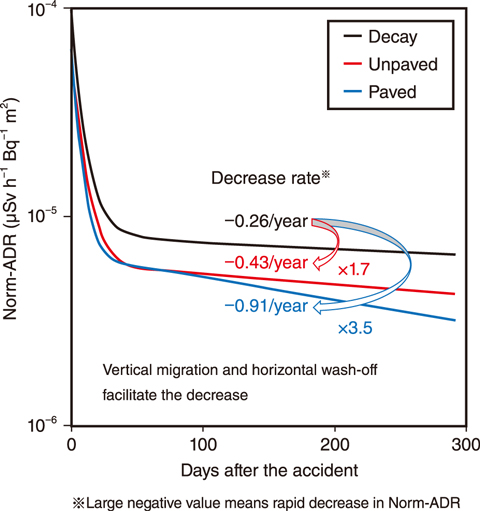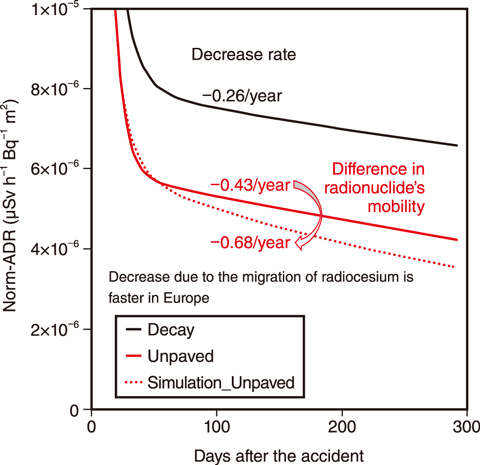
Fig.1-31 Decrease in Norm-ADR of monitoring data (“Unpaved” and “Paved”) and “Decay”

Fig.1-32 Decrease in Norm-ADR of observed data “Unpaved” and simulated result “Simulation_Unpaved”
The air dose rate (ADR) is an important quantity that is used to estimate the public exposure. However, the decrease in ADR and the factors contributing to this decrease during the initial period after the TEPCO’s Fukushima Daiichi NPS accident have not been studied. In this work, collected ADR data from Fukushima Prefecture in 2011 with fine temporal resolution were analyzed to evaluate the time dependency of the ADR.
To analyze the data across various monitoring sites with different deposition levels, the ADR was normalized by dividing it by the initial deposition amount of 137Cs. The normalized data (norm-ADR) were categorized into two data sets: unpaved areas (≥50% covered by grassland and bush) and paved areas (≥50% covered by paved surfaces and buildings). The resulting time dependencies of the norm-ADR of the unpaved and paved areas, in addition to the decrease due to radionuclide decay, are shown in Fig.1-31. All situations of the norm-ADR decreased rapidly immediately after the accident, followed by a slower decrease. The rapid decrease during the initial period was mainly due to the decay of 131I and 132I (with half-lives of 8 days and 2.3 hours, respectively). The norm-ADR of the observed data decreased faster than the decay of radionuclides after the initial period, and the norm-ADR decreased faster in paved regions than in unpaved regions (paved and unpaved in Fig.1-31, respectively). These results indicate that the decrease in the ADR is facilitated by radionuclide migration in the environment (e.g., vertical penetration and horizontal wash-off), and that this effect depends on the surface. Since urban areas are largely covered by impermeable components such as roads, their ADR was inferred to decrease more rapidly than other unpaved areas such as agricultural fields and forest, reducing the exposure of local residents.
The decrease in the ADR due to the migration of radionuclides has been studied extensively in Europe after the Chernobyl Nuclear Power Plant accident. To compare the decrease rate between Fukushima and Europe, the decrease in the norm-ADR was simulated based on the decrease rate observed in Europe and using the radionuclide’s composition in Fukushima. The results, summarized in Fig.1-32, demonstrated a faster decrease in the Norm-ADR simulated unpaved surface using data from the Chernobyl area (Simulation_Unpaved) than the unpaved regions of Fukushima. This results suggest that the radiocesium migration associated with the decrease in the ADR was less in Fukushima than in the Chernobyl area.
These results will help to retrospectively estimate the ADR and exposure of local residents.
(Kazuya Yoshimura)